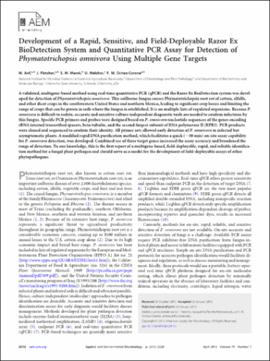| dc.contributor.author | Arif, M. | |
| dc.contributor.author | Fletcher, J. | |
| dc.contributor.author | Marek, S. M. | |
| dc.contributor.author | Melcher, U. | |
| dc.contributor.author | Ochoa-Corona, F. M. | |
| dc.date.accessioned | 2018-09-21T17:51:26Z | |
| dc.date.available | 2018-09-21T17:51:26Z | |
| dc.date.issued | 2013-04 | |
| dc.identifier | oksd_arif_developmentofa_2013 | |
| dc.identifier.citation | Arif, M., Fletcher, J., Marek, S. M., Melcher, U., & Ochoa-Corona, F. M. (2013). Development of a rapid, sensitive, and field-deployable Razor Ex BioDetection system and quantitative PCR assay for detection of Phymatotrichopsis omnivora using multiple gene targets. Applied and Environmental Microbiology, 79(7), 2312-2320. https://doi.org/10.1128/AEM.03239-12 | |
| dc.identifier.uri | https://hdl.handle.net/11244/301744 | |
| dc.description.abstract | A validated, multigene-based method using real-time quantitative PCR (qPCR) and the Razor Ex BioDetection system was developed for detection of Phymatotrichopsis omnivora. This soilborne fungus causes Phymatotrichopsis root rot of cotton, alfalfa, and other dicot crops in the southwestern United States and northern Mexico, leading to significant crop losses and limiting the range of crops that can be grown in soils where the fungus is established. It is on multiple lists of regulated organisms. Because P. omnivora is difficult to isolate, accurate and sensitive culture-independent diagnostic tools are needed to confirm infections by this fungus. Specific PCR primers and probes were designed based on P. omnivora nucleotide sequences of the genes encoding rRNA internal transcribed spacers, beta-tubulin, and the second-largest subunit of RNA polymerase II (RPB2). PCR products were cloned and sequenced to confirm their identity. All primer sets allowed early detection of P. omnivora in infected but asymptomatic plants. A modified rapid DNA purification method, which facilitates a quick (about 30-min) on-site assay capability for P. omnivora detection, was developed. Combined use of three target genes increased the assay accuracy and broadened the range of detection. To our knowledge, this is the first report of a multigene-based, field-deployable, rapid, and reliable identification method for a fungal plant pathogen and should serve as a model for the development of field-deployable assays of other phytopathogens. | |
| dc.format | application/pdf | |
| dc.language | en_US | |
| dc.publisher | American Society for Microbiology | |
| dc.rights | This material has been previously published. In the Oklahoma State University Library's institutional repository this version is made available through the open access principles and the terms of agreement/consent between the author(s) and the publisher. The permission policy on the use, reproduction or distribution of the material falls under fair use for educational, scholarship, and research purposes. Contact Digital Resources and Discovery Services at lib-dls@okstate.edu or 405-744-9161 for further information. | |
| dc.title | Development of a rapid, sensitive, and field-deployable Razor Ex BioDetection system and quantitative PCR assay for detection of Phymatotrichopsis omnivora using multiple gene targets | |
| osu.filename | oksd_arif_developmentofa_2013.pdf | |
| dc.description.peerreview | Peer reviewed | |
| dc.identifier.doi | 10.1128/AEM.03239-12 | |
| dc.description.department | Entomology and Plant Pathology | |
| dc.description.department | Biochemistry and Molecular Biology | |
| dc.type.genre | Article | |
| dc.type.material | Text | |
| dc.subject.keywords | polymerase chain reaction | |
